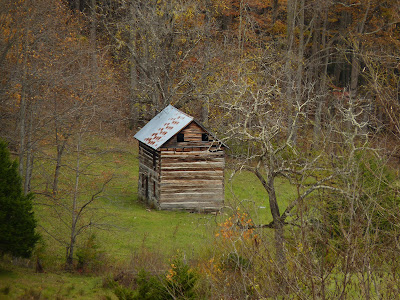Yesterday we re-drove a road we traveled over 10 years ago--I have been wanting to go back ever since. But every time we were in Grant county, WV, we were on a timeline that didn't allow for meandering the back roads.
The Smoke Holes, as locals call it, is a canyon along the South Branch of the Potomac River. Many people are surprised that the Potomac, which runs through Washington DC and into the Chesapeake Bay, is even in West Virginia, but this state is its birthplace.
The name of the canyon probably dates back to pre-white-people days. Native Americans in the area used a cave there that was smoked kinda like a funnel to smoke their meats, and the smoke rising out of an opening in the top of the cave gave the place its name. There are other explanations (moonshiners, mists rising from the canyon) but I believe the one about the early use of the cave by the natives to be the most likely.
So, here is a photo journal of our trip:
As I recall, the road was gravel our last trip. This time it was smooth new pavement most of the way.
In my last post, I posted a photo of this cabin that I took the last time we were here. This time, the grass is still green because this area has had an incredible amount of rain this year.
Notice that the cabin is three stories tall--first floor, second floor, and attic. This would have been the home of a very prosperous pioneer, probably German as the heritage of the region was made up of many German immigrants who brought the log cabin style of building with them. Earliest settlers arrived here around 1750. Imagine how wild it must have been then!
King of the Hill! Well, stump anyway...
As we neared the canyon, the road was lined with fishing camps. This is prime trout-fishing country.
Abandoned farmsteads were scattered along the road too, possibly bought out by the government when this became federal land? I'm not sure--they may be testament to the ruggedness of life in this remote area.
Finally in the canyon, a stone cellar built, my brickmason husband said, in the Italian style of stone masonry.
Nearby is this log church, originally called Palestine Church, now called St. George's, built in 1850
Tomorrow, the rest of our trip through the canyon.
Copyright Susanna Holstein. All rights reserved. No Republication or Redistribution Allowed without attribution to Susanna Holstein.














Thanks for taking us along with you.
ReplyDeleteWhat a wonderful area to explore, Sue. I always wondered where the tradition of building log cabins came from. In England churches have always been built of stone of some kind, even in areas where there's little suitable building stone and even in times when there was plenty of timber used in other buildings. So it surprises me that in the US there are so many wooden churches.
ReplyDeleteJohn, wood churches and other buildings made sense here for several reasons. In early days, the land had to be cleared of giant forests in many places. So it just made sense to recycle the logs into buildings.The log buildings often used stones, sticks and other filler between the logs and then covered with a thick mud mixed with sand or limestone if it was available, for the chinking. It would have to be re-done every so often but it worked. In the midwest, lumber and stone were both scarce. I don't know much about early buildings except that I do know that many homes were "soddies"--built from "bricks" made by rolling up sod and stacking them. The roof would usually be sod too. You used what you had.
ReplyDeleteThe log church in my photos is a good example of making do with what they had. The soil in this area in particular is very, very rocky. Stone-working tools would have been a scarce commodity, but everyone had the tools for dealing with wood. The original roof may have been overlapping boards originally, or possibly slate, although that's unlikely.
The original builders of log buildings in the US were probably the Swedes who settled in an area near Philadelphia called New Sweden--Larry's family settled there, actually, around 1640. This type of building was common in Sweden where the tall evergreen forests provided plenty of material. It didn't take long here for other settlers to copy the Swedes, though!
ReplyDelete